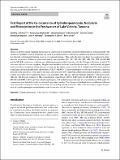| dc.description.abstract | Abstract
There is a global concern regarding the increase of cyanotoxins in freshwater and their potential effects on human health. The
existence of multiple toxins in freshwater can result in an increased risk of their bioaccumulation in humans from their inges-
tion through contaminated drinking water or recreational activities. This study, the first of its kind, was conducted to deter-
mine the occurrence of thirteen cyanotoxins namely; microcystins (-LA, -LF, -LR, -LY, -LW, -RR, -YR, -WR, dm MC-RR
and dm MC-LR), anatoxin-a, nodularin and cylindrospermopsin in the freshwaters of Lake Victoria in Tanzania. A total of 23
sites were selected for water sampling. Samples were randomly collected from lakeshores (n = 54), wells (n = 66) and piped
water (n = 18) in two phases, February (dry season) and December (rainy season) 2018. Samples (n = 138) were analysed
using liquid chromatography mass spectrometry (UPLC-MS/MS). Cylindrospermopsin was the most abundant cyanotoxin
detected in the lakeshores, with eight of the nine collection sites (89%) reporting cylindrospermopsin in phase I, compared
to three out of nine (33%) in phase II. Microcystin congeners -RR, -LR and -YR were detected in phase I, with microcystins
-RR and -LR detected in phase II. MC concentrations ranged from 0.003 to 0.007 μg/L for MC-RR, 0.01–0.013 μg/L for
MC-LR and 0.004 to 0.01 μg/L for cylindrospermopsin, with nodularin reported once at a concentration of 0.01 μg/L. No
cyanotoxins were detected in wells or in treated pipe water samples. The existence of multiple toxins in different collection
sites may lead to synergistic effects and increase the toxicological risk to humans. This is the first study to report the pres-
ence of cylindrospermopsin and nodularin in the freshwaters of Lake Victoria | en_US |

